Abstract
The thermic effect of infused glucose and insulin was measured by combining the hyperinsulinemic euglycemic clamp technique with indirect calorimetry, in 10 normal weight volunteers (group I), 7 obese subjects with normal glucose tolerance (group II), and 13 obese subjects with abnormal glucose tolerance or noninsulin-dependent diabetes mellitus before (group IIIa) and after weight loss of 10.8 +/- 0.4 kg (group IIIb). During hyperinsulinemia (760-1,100 pmol/liter), total glucose disposal from combined endogenous production and glucose infusion was 545 +/- 49, 441 +/- 70, 233 +/- 35, 231 +/- 31 mg/min and energy expenditure changed by + 0.476 +/- 0.080, +0.293 +/- 0.095, -0.114 +/- 0.063, and +0.135 +/- 0.082 kJ/min in group I, II, IIIa, and IIIb, respectively. The increased energy expenditure correlated with glucose storage (measured cost of processing the glucose: 1.33 kJ/g). In group IIIa there was no increase in energy expenditure in response to glucose and insulin infusions. After therapy (group IIIb) there was a significant recovery (P less than 0.05) of the thermic effect of infused glucose although total glucose disposal was unchanged. It is proposed that the recovered thermic effect of infused insulin/glucose is due to the different contributions of gluconeogenesis in the fasting state and during the glucose clamp before and after weight loss. In addition we hypothesize that some of the lower thermic effect of food reported in obese noninsulin-dependent diabetics may be explained by decreased energy expenditure due to a greater suppression of hepatic gluconeogenesis as well as by lower storage rate.
Full text
PDF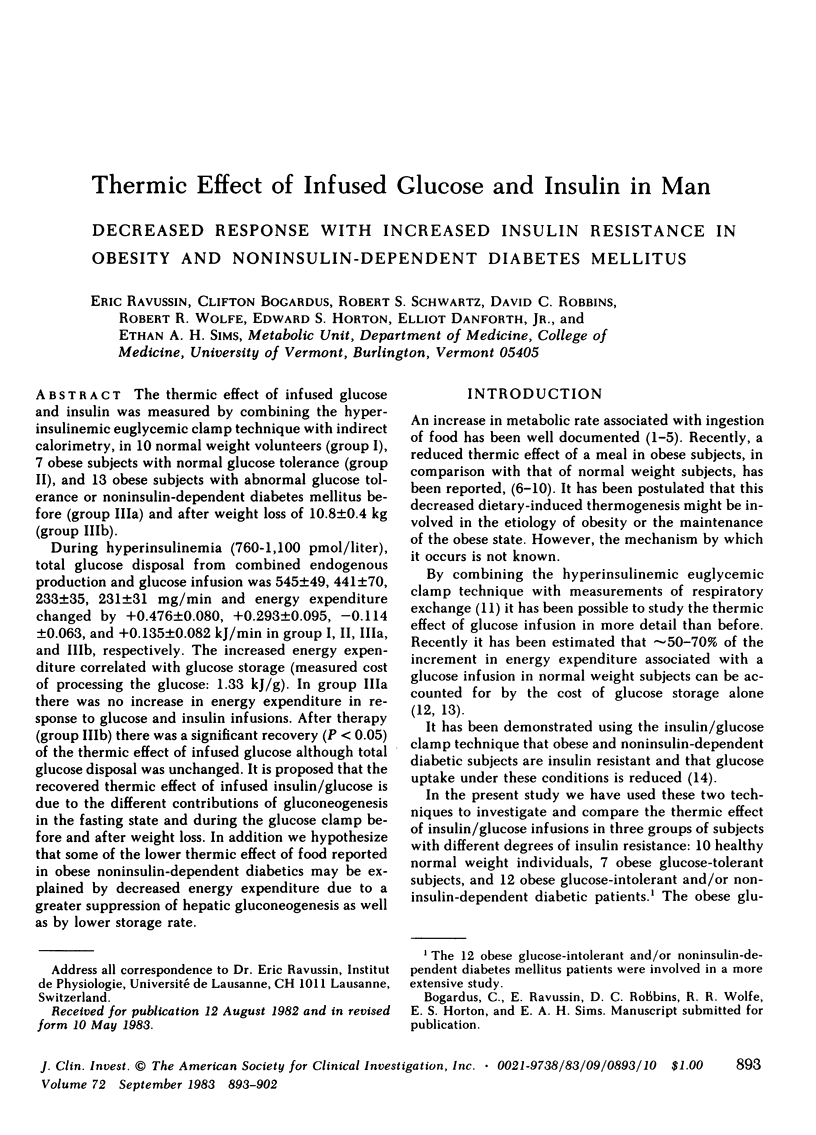
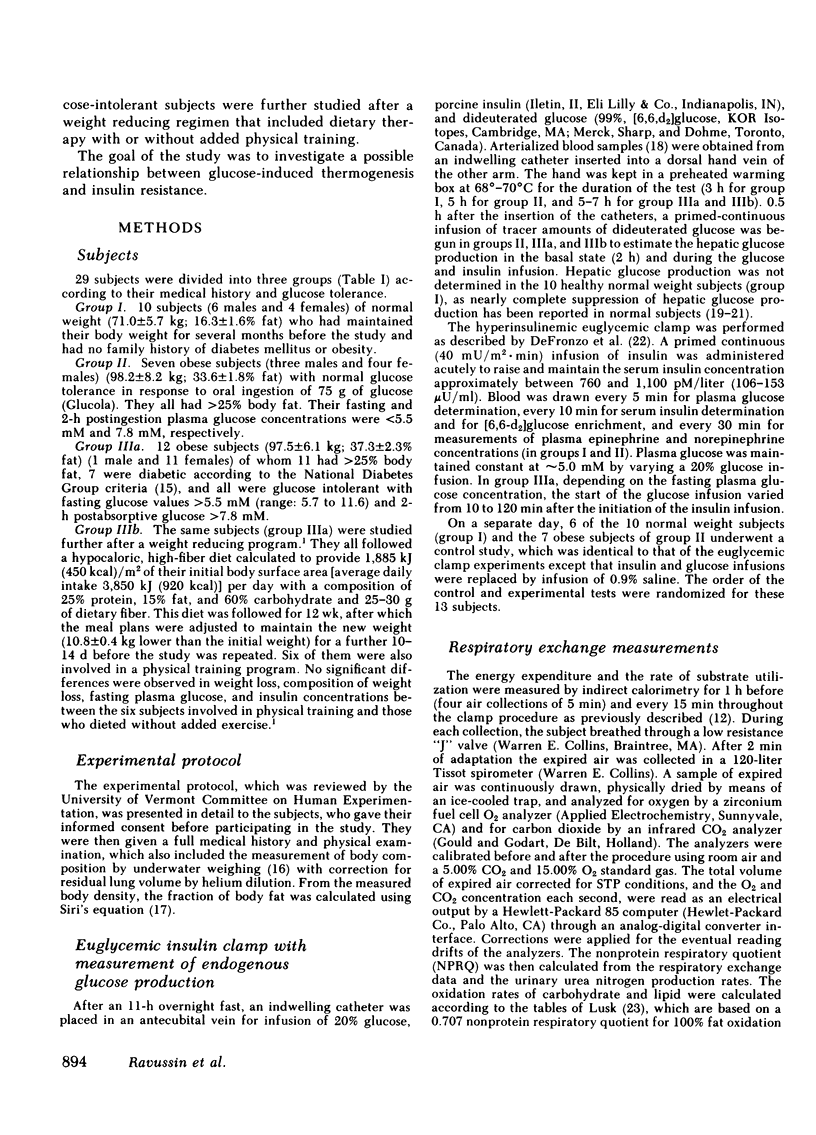
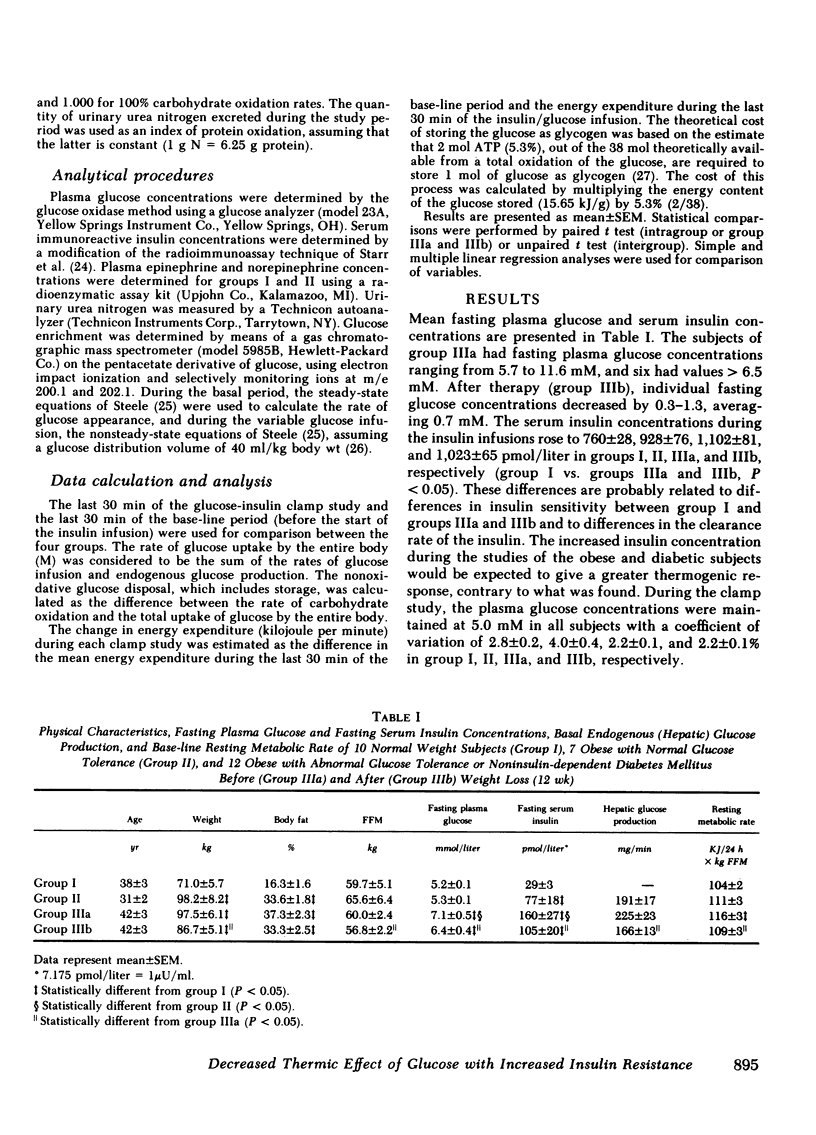
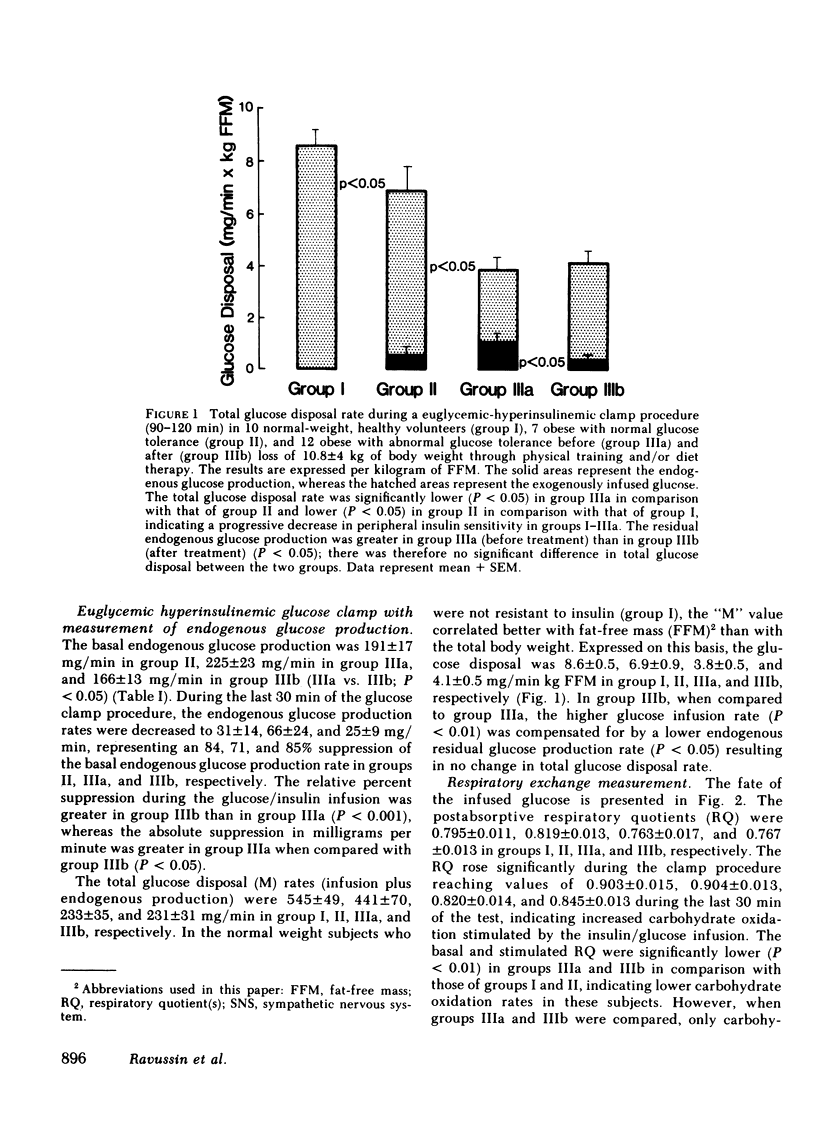
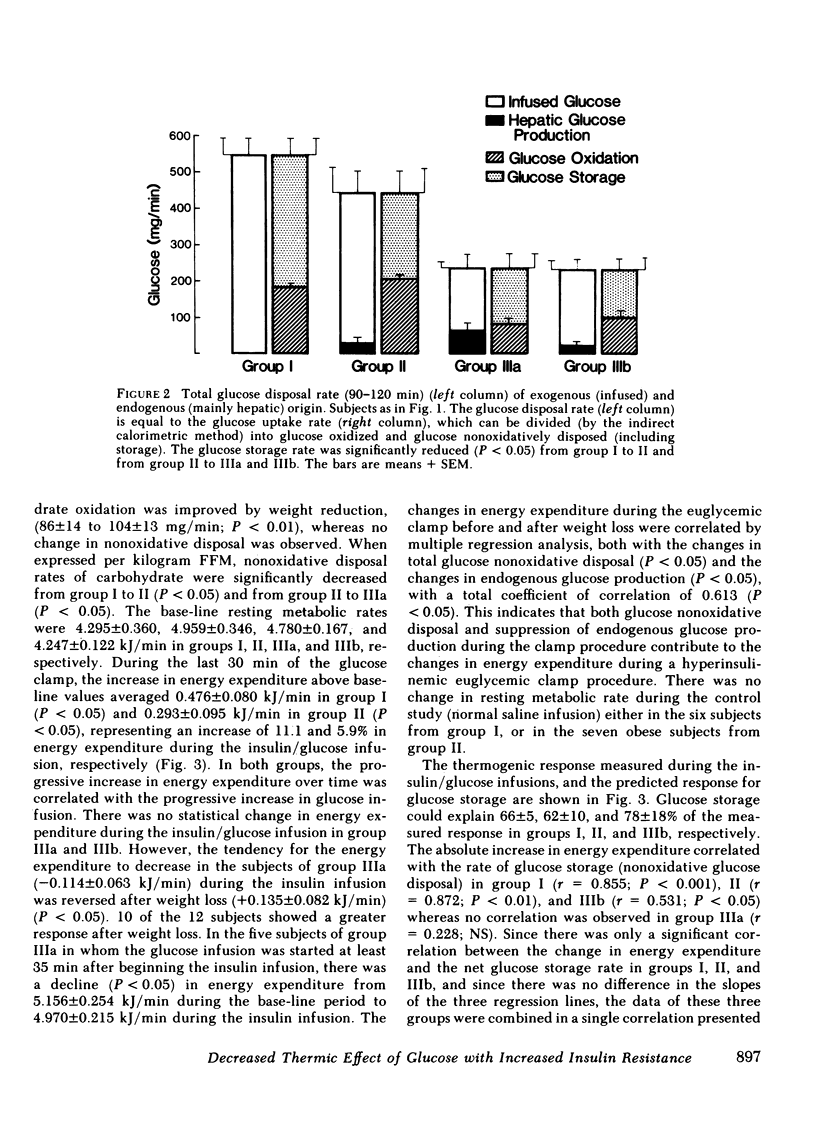
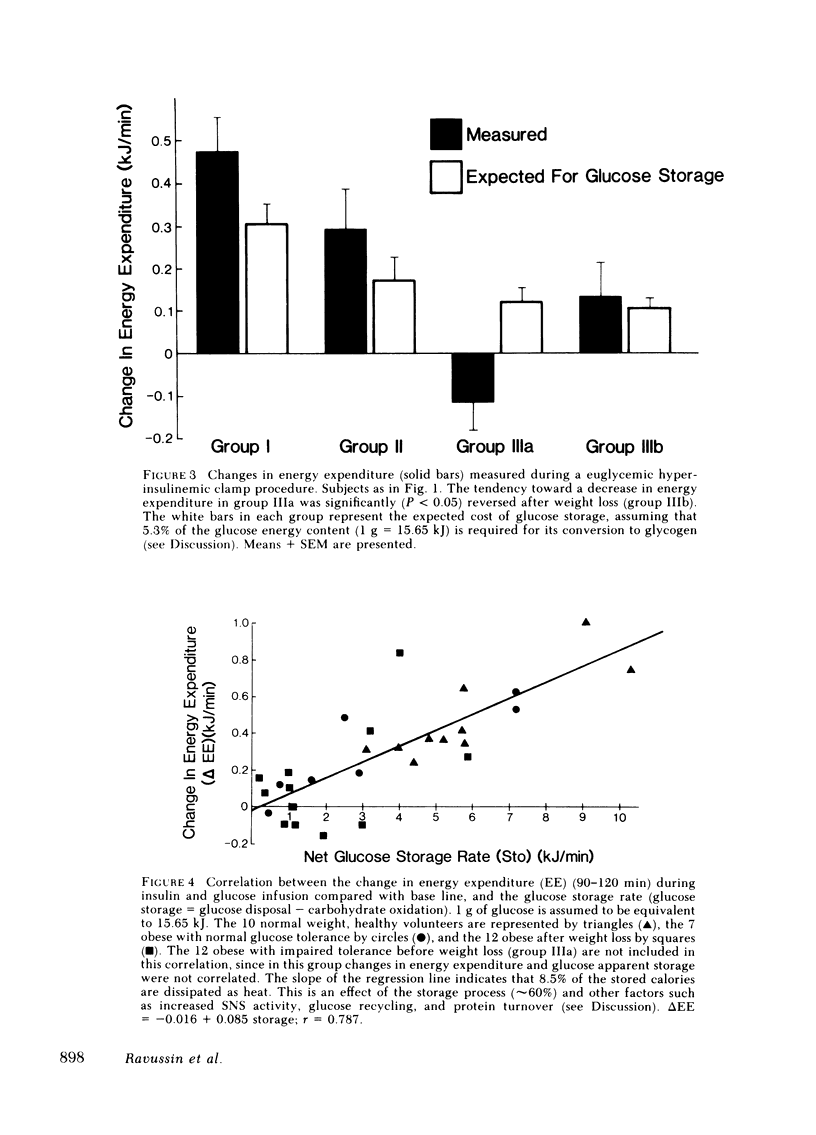
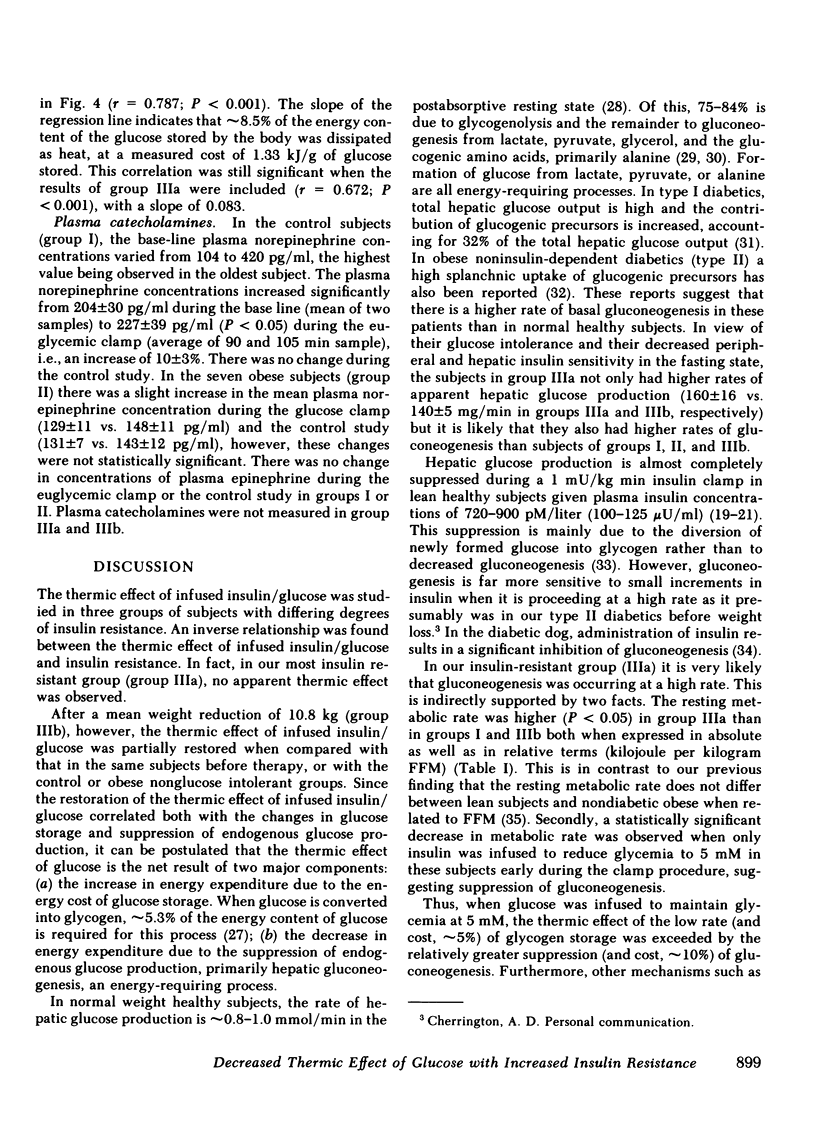
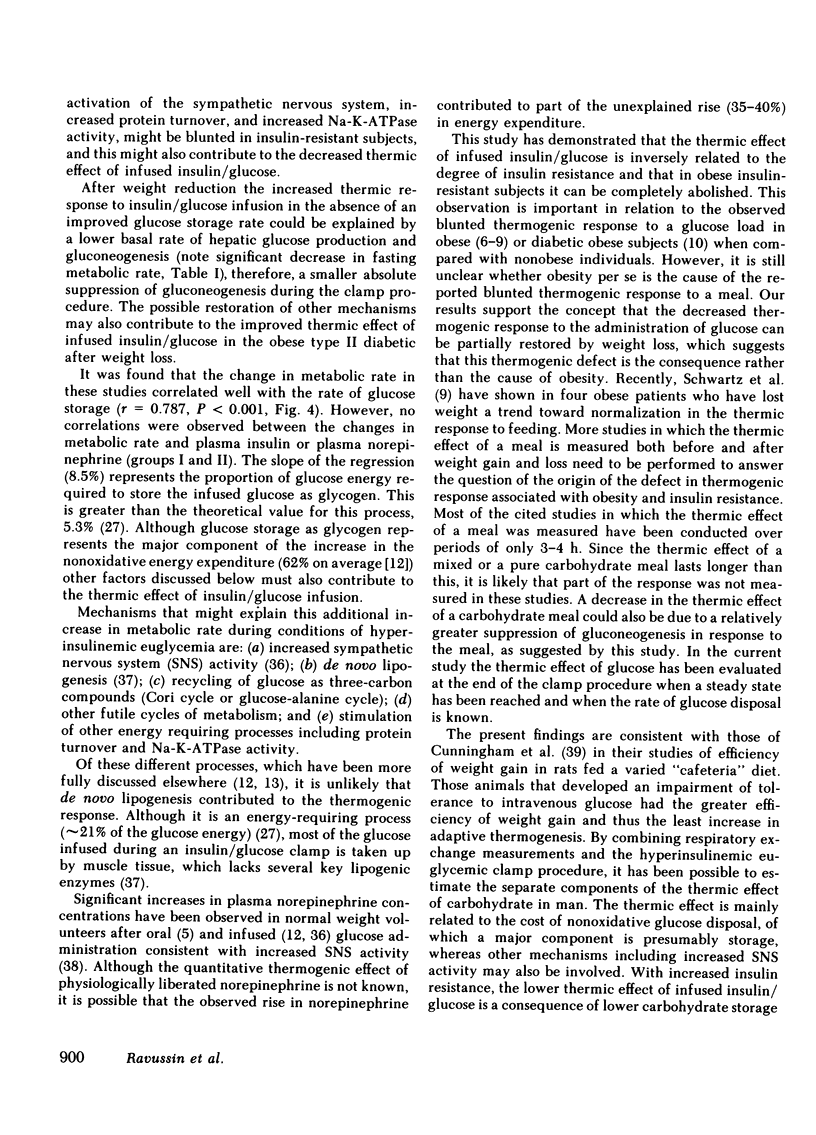
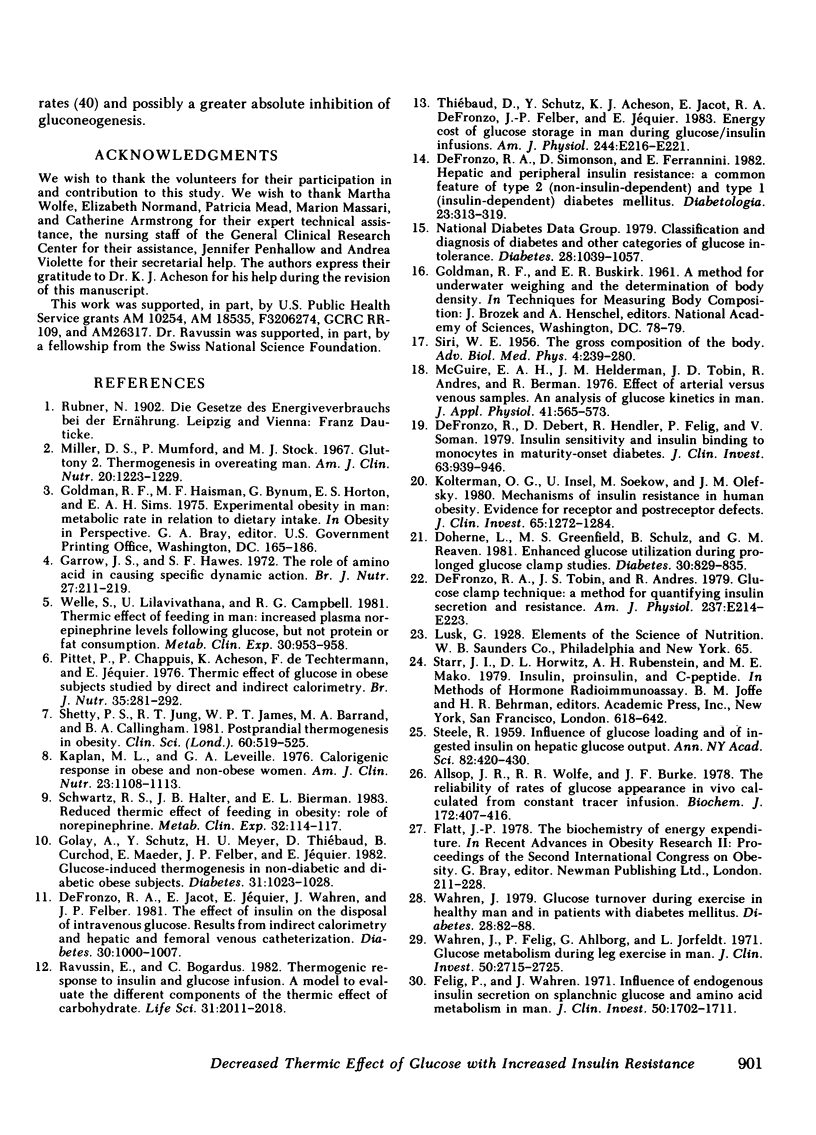
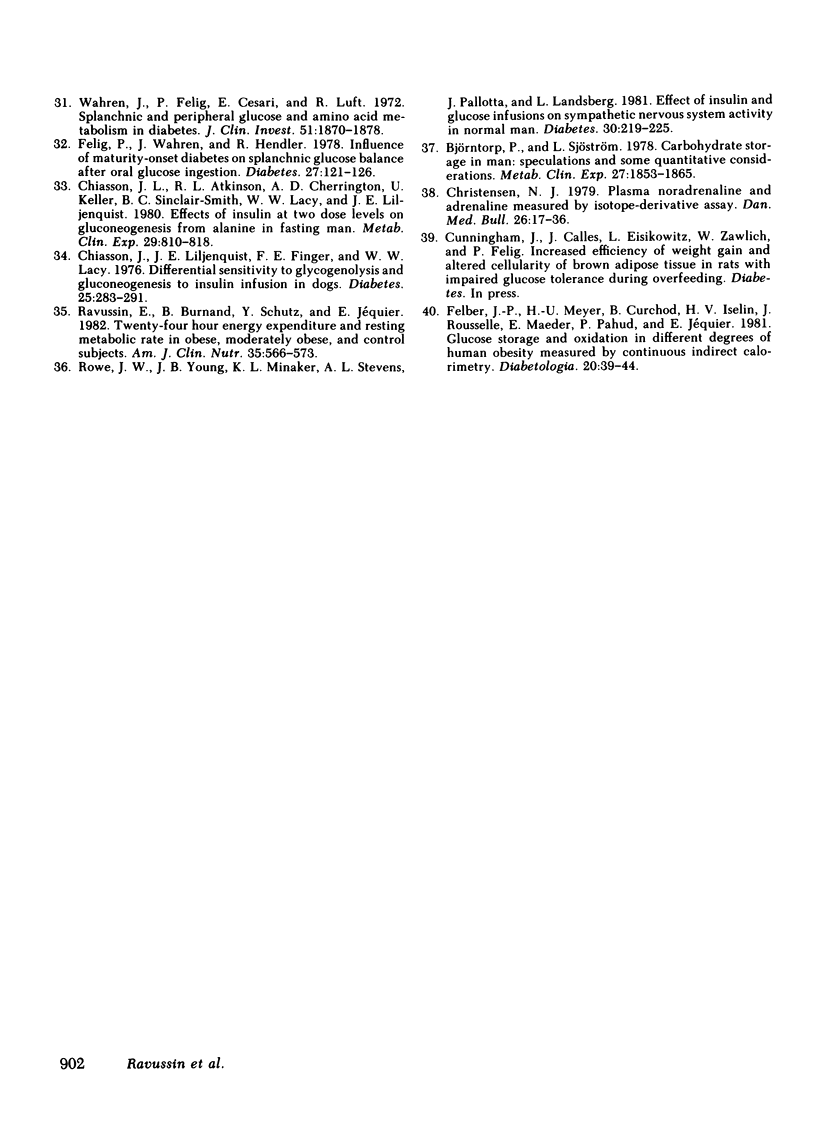
Selected References
These references are in PubMed. This may not be the complete list of references from this article.
- Allsop J. R., Wolfe R. R., Burke J. F. The realiability of rates of glucose appearance in vivo calculated from constant tracer infusions. Biochem J. 1978 Jun 15;172(3):407–416. doi: 10.1042/bj1720407. [DOI] [PMC free article] [PubMed] [Google Scholar]
- Björntorp P., Sjöström L. Carbohydrate storage in man: speculations and some quantitative considerations. Metabolism. 1978 Dec;27(12 Suppl 2):1853–1865. doi: 10.1016/s0026-0495(78)80004-3. [DOI] [PubMed] [Google Scholar]
- Chiasson J. L., Atkinson R. L., Cherrington A. D., Keller U., Sinclair-Smith B. C., Lacy W. W., Liljenquist J. E. Effects of insulin at two dose levels on gluconeogenesis from alanine in fasting man. Metabolism. 1980 Sep;29(9):810–818. doi: 10.1016/0026-0495(80)90119-5. [DOI] [PubMed] [Google Scholar]
- Chiasson J. L., Liljenquist J. E., Finger F. E., Lacy W. W. Differential sensitivity of glycogenolysis and gluconeogenesis to insulin infusions in dogs. Diabetes. 1976 Apr;25(4):283–291. doi: 10.2337/diab.25.4.283. [DOI] [PubMed] [Google Scholar]
- Christensen N. J. Plasma noradrenaline and adrenaline measured by isotope-derivative assay. A review with special reference to diabetes mellitus. Dan Med Bull. 1979 Feb;26(1):17–36. [PubMed] [Google Scholar]
- DeFronzo R. A., Jacot E., Jequier E., Maeder E., Wahren J., Felber J. P. The effect of insulin on the disposal of intravenous glucose. Results from indirect calorimetry and hepatic and femoral venous catheterization. Diabetes. 1981 Dec;30(12):1000–1007. doi: 10.2337/diab.30.12.1000. [DOI] [PubMed] [Google Scholar]
- DeFronzo R. A., Simonson D., Ferrannini E. Hepatic and peripheral insulin resistance: a common feature of type 2 (non-insulin-dependent) and type 1 (insulin-dependent) diabetes mellitus. Diabetologia. 1982 Oct;23(4):313–319. doi: 10.1007/BF00253736. [DOI] [PubMed] [Google Scholar]
- DeFronzo R. A., Tobin J. D., Andres R. Glucose clamp technique: a method for quantifying insulin secretion and resistance. Am J Physiol. 1979 Sep;237(3):E214–E223. doi: 10.1152/ajpendo.1979.237.3.E214. [DOI] [PubMed] [Google Scholar]
- DeFronzo R., Deibert D., Hendler R., Felig P., Soman V. Insulin sensitivity and insulin binding to monocytes in maturity-onset diabetes. J Clin Invest. 1979 May;63(5):939–946. doi: 10.1172/JCI109394. [DOI] [PMC free article] [PubMed] [Google Scholar] [Retracted]
- Doberne L., Greenfield M. S., Schulz B., Reaven G. M. Enhanced glucose utilization during prolonged glucose clamp studies. Diabetes. 1981 Oct;30(10):829–835. doi: 10.2337/diab.30.10.829. [DOI] [PubMed] [Google Scholar]
- Felber J. P., Meyer H. U., Curchod B., Iselin H. U., Rousselle J., Maeder E., Pahud P., Jéquier E. Glucose storage and oxidation in different degrees of human obesity measured by continuous indirect calorimetry. Diabetologia. 1981;20(1):39–44. doi: 10.1007/BF00253814. [DOI] [PubMed] [Google Scholar]
- Felig P., Wahren J., Hendler R. Influence of maturity-onset diabetes on splanchnic glucose balance after oral glucose ingestion. Diabetes. 1978 Feb;27(2):121–126. doi: 10.2337/diab.27.2.121. [DOI] [PubMed] [Google Scholar]
- Felig P., Wahren J. Influence of endogenous insulin secretion on splanchnic glucose and amino acid metabolism in man. J Clin Invest. 1971 Aug;50(8):1702–1711. doi: 10.1172/JCI106659. [DOI] [PMC free article] [PubMed] [Google Scholar]
- Garrow J. S., Hawes S. F. The role of amino acid oxidation in causing specific dynamic action' in man. Br J Nutr. 1972 Jan;27(1):211–219. doi: 10.1079/bjn19720084. [DOI] [PubMed] [Google Scholar]
- Golay A., Schutz Y., Meyer H. U., Thiébaud D., Curchod B., Maeder E., Felber J. P., Jéquier E. Glucose-induced thermogenesis in nondiabetic and diabetic obese subjects. Diabetes. 1982 Nov;31(11):1023–1028. doi: 10.2337/diacare.31.11.1023. [DOI] [PubMed] [Google Scholar]
- Kaplan M. L., Leveille G. A. Calorigenic response in obese and nonobese women. Am J Clin Nutr. 1976 Oct;29(10):1108–1113. doi: 10.1093/ajcn/29.10.1108. [DOI] [PubMed] [Google Scholar]
- Kolterman O. G., Insel J., Saekow M., Olefsky J. M. Mechanisms of insulin resistance in human obesity: evidence for receptor and postreceptor defects. J Clin Invest. 1980 Jun;65(6):1272–1284. doi: 10.1172/JCI109790. [DOI] [PMC free article] [PubMed] [Google Scholar]
- McGuire E. A., Helderman J. H., Tobin J. D., Andres R., Berman M. Effects of arterial versus venous sampling on analysis of glucose kinetics in man. J Appl Physiol. 1976 Oct;41(4):565–573. doi: 10.1152/jappl.1976.41.4.565. [DOI] [PubMed] [Google Scholar]
- Miller D. S., Mumford P., Stock M. J. Gluttony. 2. Thermogenesis in overeating man. Am J Clin Nutr. 1967 Nov;20(11):1223–1229. doi: 10.1093/ajcn/20.11.1223. [DOI] [PubMed] [Google Scholar]
- Pittet P., Chappuis P., Acheson K., De Techtermann F., Jéquier E. Thermic effect of glucose in obese subjects studied by direct and indirect calorimetry. Br J Nutr. 1976 Mar;35(2):281–292. doi: 10.1079/bjn19760033. [DOI] [PubMed] [Google Scholar]
- Ravussin E., Bogardus C. Thermogenic response to insulin and glucose infusions in man: a model to evaluate the different components of the thermic effect of carbohydrate. Life Sci. 1982 Nov 1;31(18):2011–2018. doi: 10.1016/0024-3205(82)90040-6. [DOI] [PubMed] [Google Scholar]
- Ravussin E., Burnand B., Schutz Y., Jéquier E. Twenty-four-hour energy expenditure and resting metabolic rate in obese, moderately obese, and control subjects. Am J Clin Nutr. 1982 Mar;35(3):566–573. doi: 10.1093/ajcn/35.3.566. [DOI] [PubMed] [Google Scholar]
- Rowe J. W., Young J. B., Minaker K. L., Stevens A. L., Pallotta J., Landsberg L. Effect of insulin and glucose infusions on sympathetic nervous system activity in normal man. Diabetes. 1981 Mar;30(3):219–225. doi: 10.2337/diab.30.3.219. [DOI] [PubMed] [Google Scholar]
- SIRI W. E. The gross composition of the body. Adv Biol Med Phys. 1956;4:239–280. doi: 10.1016/b978-1-4832-3110-5.50011-x. [DOI] [PubMed] [Google Scholar]
- STEELE R. Influences of glucose loading and of injected insulin on hepatic glucose output. Ann N Y Acad Sci. 1959 Sep 25;82:420–430. doi: 10.1111/j.1749-6632.1959.tb44923.x. [DOI] [PubMed] [Google Scholar]
- Schwartz R. S., Halter J. B., Bierman E. L. Reduced thermic effect of feeding in obesity: role of norepinephrine. Metabolism. 1983 Feb;32(2):114–117. doi: 10.1016/0026-0495(83)90214-7. [DOI] [PubMed] [Google Scholar]
- Shetty P. S., Jung R. T., James W. P., Barrand M. A., Callingham B. A. Postprandial thermogenesis in obesity. Clin Sci (Lond) 1981 May;60(5):519–525. doi: 10.1042/cs0600519. [DOI] [PubMed] [Google Scholar]
- Thiebaud D., Schutz Y., Acheson K., Jacot E., DeFronzo R. A., Felber J. P., Jequier E. Energy cost of glucose storage in human subjects during glucose-insulin infusions. Am J Physiol. 1983 Mar;244(3):E216–E221. doi: 10.1152/ajpendo.1983.244.3.E216. [DOI] [PubMed] [Google Scholar]
- Wahren J., Felig P., Ahlborg G., Jorfeldt L. Glucose metabolism during leg exercise in man. J Clin Invest. 1971 Dec;50(12):2715–2725. doi: 10.1172/JCI106772. [DOI] [PMC free article] [PubMed] [Google Scholar]
- Wahren J., Felig P., Cerasi E., Luft R. Splanchnic and peripheral glucose and amino acid metabolism in diabetes mellitus. J Clin Invest. 1972 Jul;51(7):1870–1878. doi: 10.1172/JCI106989. [DOI] [PMC free article] [PubMed] [Google Scholar]
- Wahren J. Glucose turnover during exercise in healthy man and in patients with diabetes mellitus. Diabetes. 1979 Jan;28 (Suppl 1):82–88. doi: 10.2337/diab.28.1.s82. [DOI] [PubMed] [Google Scholar]
- Welle S., Lilavivat U., Campbell R. G. Thermic effect of feeding in man: increased plasma norepinephrine levels following glucose but not protein or fat consumption. Metabolism. 1981 Oct;30(10):953–958. doi: 10.1016/0026-0495(81)90092-5. [DOI] [PubMed] [Google Scholar]


